Whether you’re serving up coleslaw at a deli counter, portioning sauces for takeout, or prepping meals for retail shelves, deli containers are a quiet but essential part of the operation. These simple containers help keep food fresh, presentable, and easy to transport—making them a must-have for foodservice, catering, and retail businesses alike.
But not all deli containers are created equal. Choosing the right size doesn’t just affect storage—it can impact portion control, reduce food waste, and elevate the customer experience. From 2 oz sauce cups to 32 oz family-sized portions, each size serves a specific purpose.
Let’s explore the most common deli container sizes and how to choose the right fit for your business.
Why Container Size Counts
Selecting the appropriate deli container size is more than just a logistical decision. It affects your customers’ experience, makes your food look its best and even saves you money! Each container size option has its own advantages and disadvantages to the establishment and the patron.
Perfect Portions, Happy Customers

When you serve food in an expected, appropriate container, you help the guest know what to expect. If the container is filled about 95% full, customers see value in their order and often feel satisfied with the portion.
For main dishes, think about enough food for one serving per person at least. Aim for 90% of humans being satisfied, with a morsel perhaps to save for another time. Much of the negative feedback we see related to food value stems from portions appearing too skimpy, an issue that usually circles back to container selection.
When you get this one right, you will have less complaints and more repeat business.
Maximize Your Storage Space
Container size makes an impact behind the counter. Choosing sizes that stack easily maximizes storage space in your refrigerator or deli case.
Using smaller containers will make it easier to stay organized. Packing too much food into too small a space means messy spills and irate employees! When you pick the proper size, it leads to less mess, less wasted ingredients and more storage efficiency.
Boost Your Food’s Appeal
Food that is presented well in a container that’s the right size will always be more appealing. When containers are packed all the way to the brim, meals appear abundant and inviting.
This can improve the way patrons perceive the food and encourage them to return.
Link Size to Satisfaction
A proper match between food and container type is essential to delivering value. A container that is truly too large and looks half empty can end up being a letdown.
Similarly, an undersized and overstuffed container is bound to disappoint them. The right size is about building trust and bringing people back.
Your Guide: Deli Container Sizes
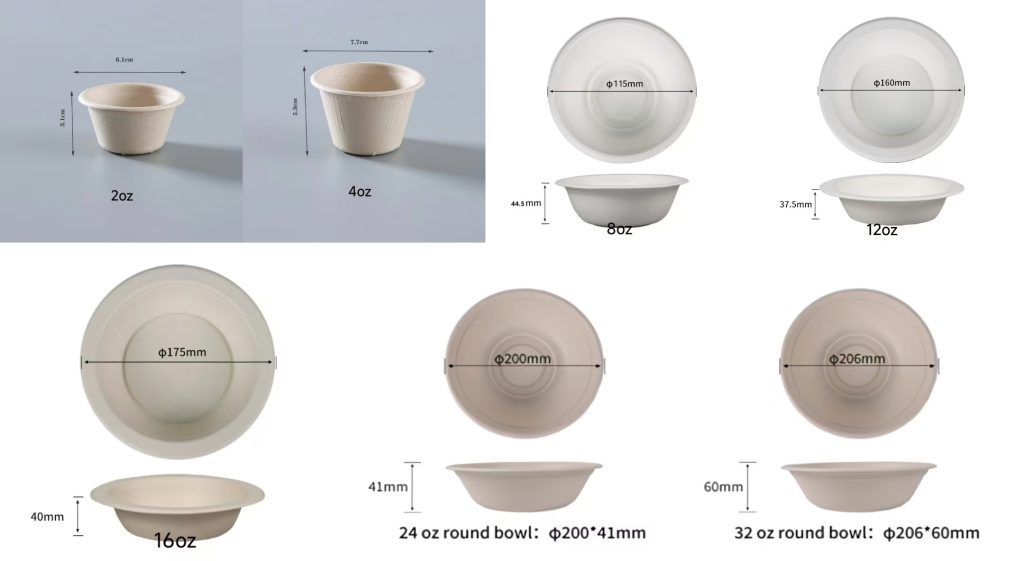
Deli containers are indispensable in consumer home kitchens, as well as commercial kitchens and food businesses across the country. This is particularly true in booming cities like LA where takeout and meal prep are both booming!
These versatile containers are available in an almost endless variety of sizes, each one designed to hold a unique task. Whether you’re putting away leftovers, making a whole pot of soup to share, or distributing sauces with delivery orders, understanding the deli container size options will ensure that you choose the right product for your needs!
1. Mini 2 oz & 4 oz: Sauces, Samples, and More
The smallest deli containers, particularly the 2 oz and 4 oz sizes, are the go-to for sauces and condiments. In bustling delis from Santa Monica to Silver Lake, these mini cups help everyone stay tidy and buttoned up. Restaurants take advantage of them to offer salad dressings, basic condiments like ketchup and mustard, or a sample of a new dish being introduced. This size is key for food sampling! Consider the establishments that let you sample a spoonful of soup or a dab of dip before you make a purchase.
Since they are small, they’re convenient for at-home meal prep too. Other people take advantage of them to pack nuts, fruit, or trail mix for a wholesome snack on the run. Featuring a universal lid that fits the 2 oz and 4 oz size, saving storage space has never been easier or more stackable, especially in a lid combo pack.
This versatility not only benefits restaurants but also enhances the functionality of home kitchens. With the option to use these containers for different types of food, they truly serve multiple purposes.
2. Compact 8 oz: Sides & Sauces
Continuin the list, the compact 8 oz deli container is a classic choice for sides and sauces. In Los Angeles, you’ll find these in use for coleslaw, potato salad, or a double side of beans at hole-in-the-wall barbecue spots.
They’re just the right size for a cup of soup! They’re handy when you just want a scoop of hummus, or a side of mac and cheese.
For home cooks, 8 oz containers cut down on easy-to-overwhelm meal prep. Portion out leftovers or snacks, and stack them in the refrigerator. We’ve found that most deli containers have a universal lid. This even means you can interchangeably use 8 oz and 12 oz without searching for the correct lid!
These containers are lightweight, too—reduced bulk in delivery bags or lunch boxes is another plus.
3. Handy 12 oz: Small Servings
The handy 12 oz container hits a trifecta of being ideal for single meal servings but slightly bigger sides. It’s a go-to choice for ladling chili, salads or a thick soup.
This is a popular size for regular bowls in many of the salad bars and poke shops up and down Southern California. This size is perfect for meal prepping, especially if you’re making lunches for the week.
It fits a satisfying amount of food minus the food waste that’s typical of larger containers. Try out the 12 oz cup for pasta, stir-fry, or grain bowls. Just like the smaller sizes, these containers stack beautifully with the same style of lid.
4. Standard 16 oz (Pint): Soups & Salads
One of the most common deli container sizes found in restaurants and home kitchens. This size works really well for soups, large salads and meals like curry or stew.
At most LA delis, you can order a matzo ball soup or ramen in one of these. When it comes to meal prep, a 16 oz container is sufficient for a generous lunch or dinner meal.
The primary use I see for them personally is for meal prep of larger things—hello massive batch of homemade chicken stock, cut-up fruit or overnight oats!
5. Roomy 24 oz: Generous Meals
The 24 oz container is ideal for larger portions or if you’re planning to send a complete meal. Many popular fast-casual spots serve up massive salads, noodle bowls, or combo plates in these beauties.
If you’re feeding a big bunch of hungry folks or just plan on having some leftovers, this size will stand up. Home cooks appreciate having 24 oz containers on hand for meal preparation. They use them to store bulk foods such as cooked grains, beans, or roasted veggies!
These containers are stackable, lightweight, and economical. Plus, they reduce food waste by making it easy to see and store what’s left from a big dinner!
6. Large 32 oz (Quart): Family Style
The large 32 oz (Quart) size is designed for family-sized meals and bulk storage. It’ll hold an entire Family Style batch of soup, stew or pasta salad.
This size is built for sharing. Whether you’re packaging food for families, catering trays, or bulk items like pasta or soup, the quart-size deli container gets the job done with ease.
7. Bulk Sizes: For Big Needs
Some deli container sizes are even larger, ranging from 48 oz to 64 oz and beyond. These options are rarely used for single serve orders. They are indispensable for big-batch meal prep, catering, or storing bulk foods such as grains, salads, or marinated proteins.
You’ll see these sizes on farmers markets, or food-buying co-ops. They’re great for family-size dips, party-pleaser platters, or big-batch meal prep.
Bulk containers provide a much deeper well. This versatility makes them ideal for holding a large batch of soup, chili, or pasta salad. They’re incredibly convenient for restaurant kitchens or even home cooks who want to prepare meals in advance and store them safely.
8. Unique Shapes: Stand Out

Other than the traditional round deli container, there are specialty shapes designed to stand out. For instance, InNature Pack has a hexagonal bagasse salad bowl available. This unique shape gives a business the opportunity to stand out! It provides a modern presentation for items such as salads, poke bowls or fruit blends.
These special containers are made from sustainable materials, which is certainly a big plus for a restaurant with a large clientele and a focus on the environment! These shapes can be functional as well—stackable, durable, comfortable to grip.
How to Choose the Right Size?
With so many sizes available, picking the right deli container can feel overwhelming—but it doesn’t have to be. Asking a few simple questions can help you make the right choice for your food, your customers, and your workflow.
1. What’s going in the container?
Start with the food itself. Sauces or condiments? Go for 2–4 oz. A soup, salad, or pasta? You’ll likely need 16 oz or more. Matching portion size to content ensures your packaging feels right—not too empty, not overfilled. Liquids need deeper, secure containers, while dry or solid foods do well in shallower options.
2. Is it for dine-in, takeout, or retail?
Your application determines the key features. Takeout and delivery need containers that are leak-resistant and stackable. For retail shelves, visibility and labeling space matter—especially for grab-and-go items. Think compact sizes (8–12 oz) for quick meals, or larger sizes (24–32 oz) for meal kits and family portions.
3. Who’s your customer?
Understanding your end user helps guide your size range. A busy lunch crowd wants single-serve portions they can carry easily. A catering client may expect bulk options for sharing. Offering a variety of sizes gives you flexibility to meet different expectations.
4. How do you store and transport them?
Packaging should support—not slow down—your kitchen. Opt for stackable, nestable containers to keep your shelves organized and prep areas efficient. Standardizing a few core sizes can speed up packing and reduce storage space.
5. What image does your packaging reflect?
Your container isn’t just functional—it’s part of your brand. Eco-conscious food brands may prefer compostable options like bagasse. Want to stand out? Consider custom-printed containers that reinforce your message. If you’re watching costs, stock sizes still allow you to make smart, efficient choices.
6. Not sure? Test before you decide.
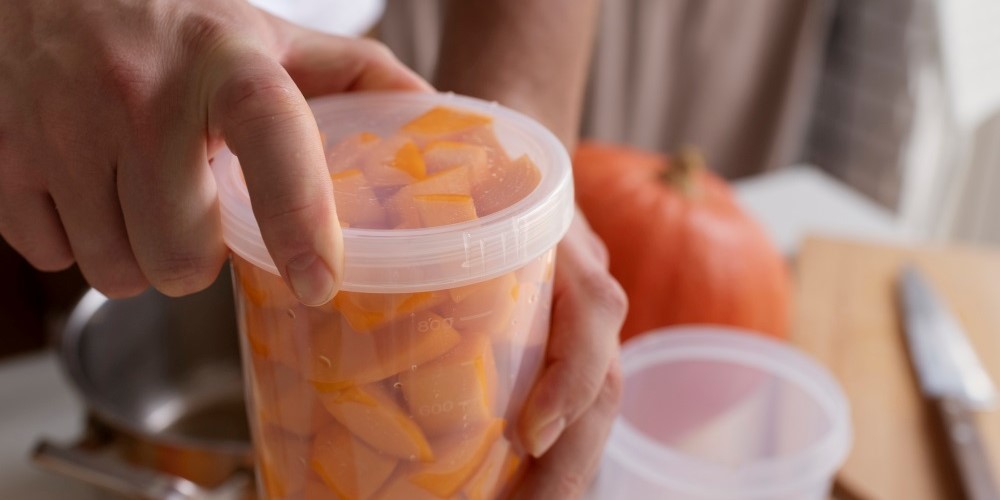
The best way to know what works is to try it. That’s why InNature Pack offers free sample support—so you can test your food with real containers and feel confident before placing an order. We’re also happy to recommend sizes based on your menu and service model.
What Are Deli Containers Made Of?
Deli containers come in different materials, and each affects food freshness, appearance, and sustainability. Here’s an explanation of the most common materials used in deli containers.
The Ubiquitous Plastic Container
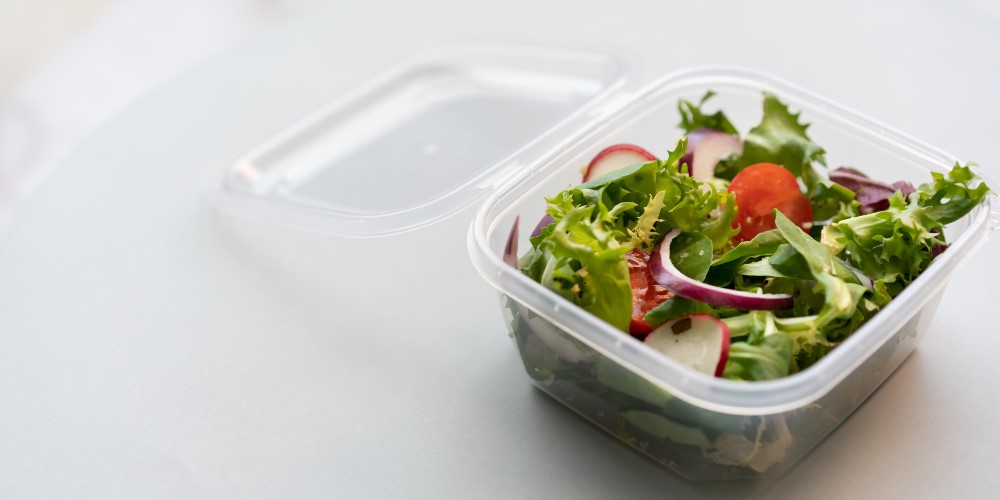
Most deli containers are plastic, usually polypropylene (PP). This plastic is durable, lightweight, and can accommodate both hot and cold foods. It’s sturdy enough for everyday use and stacks easily in the refrigerator.
Lids, typically crafted from the same material, create a strong, leak-proof seal. Customizable sizes range from 8oz for sauces to 32oz for bulk salads or soups, ensuring that conscious customers can choose the right portion size for their needs.
While these containers do an excellent job protecting food, their usage raises essential questions regarding recycling and waste management, making it vital for users to consider their preferences in food storage solutions.
Paper: An Eco-Friendlier Choice?
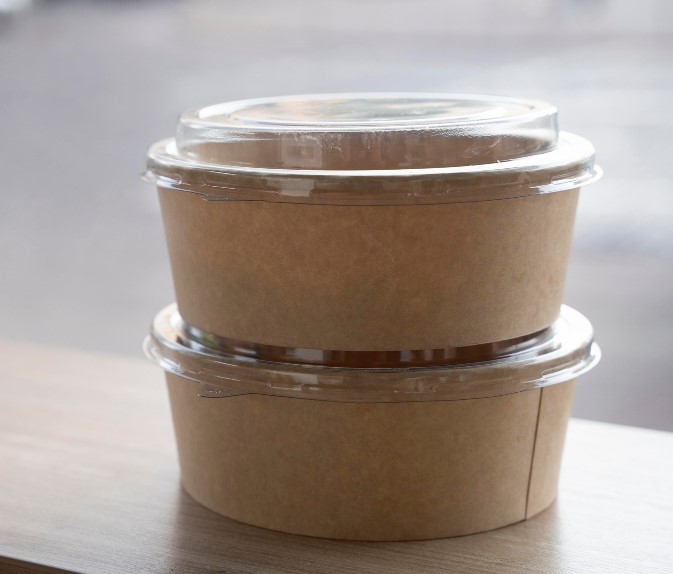
Other retailers sell deli containers made of paper that have a thin layer of plastic or wax coating their interiors. These are still only suitable for dry foods and limited duration use.
When it comes to deli containers, paper may seem like a more environmentally-friendly option, but the plastic lining usually prevents these from being recycled or composted, either.
Bagasse: Truly Compostable?
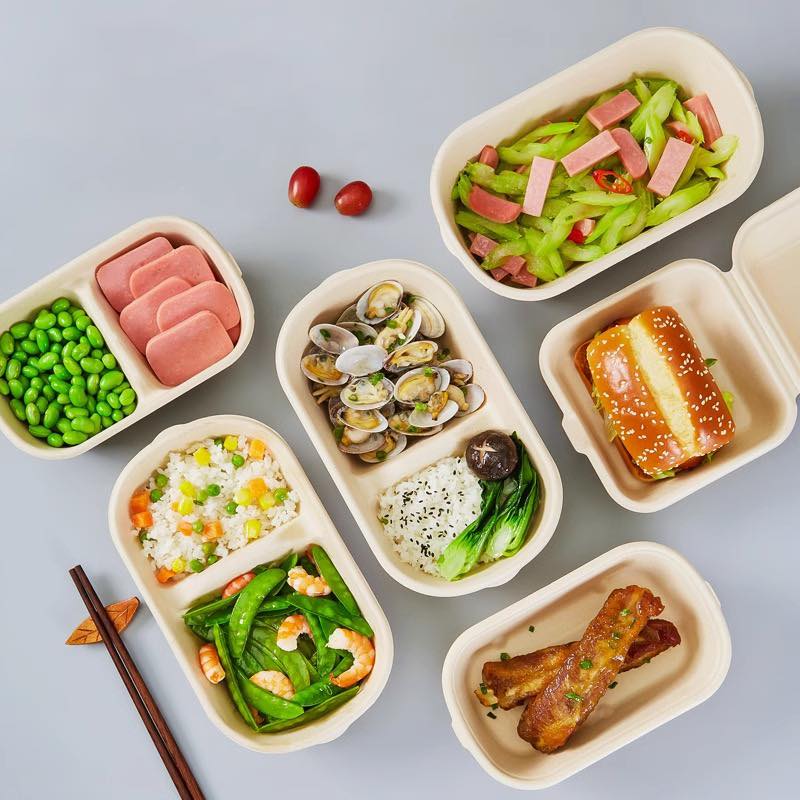
Bagasse, or what’s left over after sugarcane is processed for sugar, has been emerging as an eco-friendly alternative. It composts well in both home and industrial compost piles and performs rather well with hot foods.
Yet it’s not as widely available as plastic, and may be more expensive. Not every city is equipped to compost bagasse though.
Glass and Other Niche Options
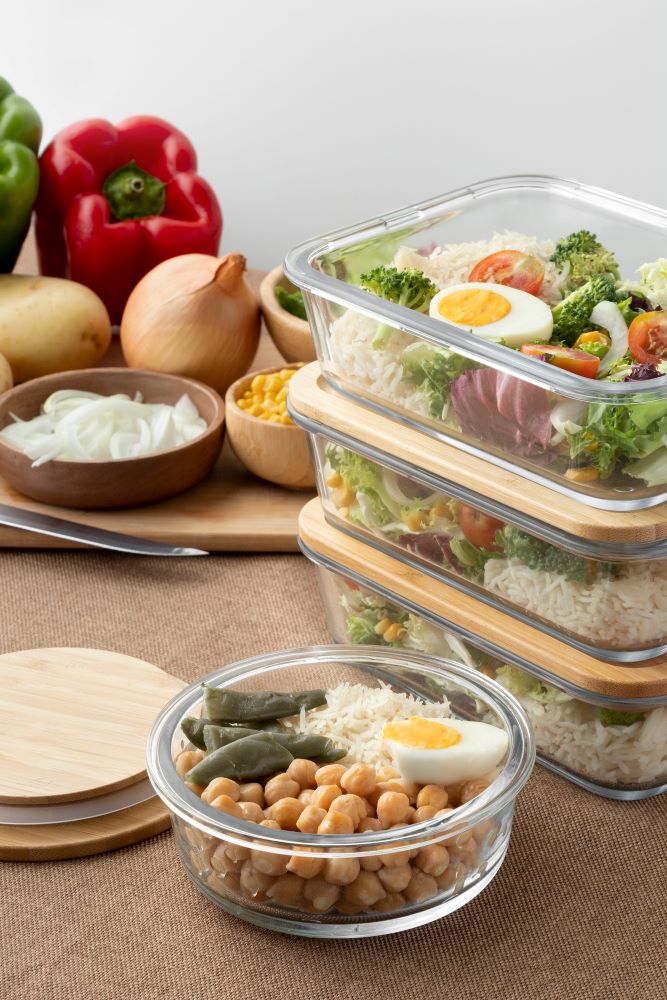
Glass deli containers are uncommon. They’re really strong, they’re really reusable, they really don’t hold odors. The downside is that glass is heavier, more expensive and breakable.
Only some high-end delis or eco-friendly shops do, the rest don’t.
How Materials Keep Food Fresh
Plastic or glass, both materials create an airtight seal, keeping food fresher for longer. Because paper and bagasse are more breathable, food could dry out more quickly.
Airtight lids are important when it comes to soups or other items with high moisture content.
More Than Size: Essential Features
Choosing a deli container isn’t just about volume—it’s also about how well it performs in real-world use. Here are the key features to look for:
Built Tough: Container Durability
Build Quality is essential. A quality container doesn’t crumble when the stakes are high. Durable plastic or high-quality biodegradable materials — such as bagasse or cornstarch — protect food from food prep through refrigeration to your door.
For delis with high customer traffic that require fast transportation, containers have to withstand falls, hard stacking, and aggressive transportation. Flimsy ones easily break, wasting precious time and food. Durability goes a long way. Durable containers last longer and reduce landfill waste.
Secure Lids: Prevent Messes

Secure lids are crucial to prevent messes. Nobody likes leaking sauce in the bottom of their bag. Leak-proof, airtight lids are essential. They prevent messy spills and help maintain food quality while moving.
Lids with advanced design and tight seals that are spill-proof are needed for soups and dressings. Our customers can feel confident their food is going to arrive in style, not looking like a dog’s dinner.
Stack Smart: Save Shelf Space
Smart, stackable deli containers save space in fridges and pantries. Their stackable, flat lids let you build orderly stacks. This makes it easier to maintain an orderly kitchen, whether you’re a commercial caterer or a home chef meal-prepping for the week.
Freezer & Microwave Safe: Heat & Chill with Ease
Containers designed for both freezer and microwave help you prep and store food faster. No need to transfer food to different containers—just heat or chill right in the deli container.
Product quality, durability, and performance are essential; rugged construction withstands high heat and deep freeze. InNature Pack’s bagasse containers are safe for refrigerator and microwave use
Eco-Friendly Options: Serve Sustainably
More stores are looking to reduce plastic pollution. Containers produced from compostable or biodegradable plastics decompose quicker and maintain a reduced landfill footprint. Sustainable options are appealing to customers.
Customers are increasingly aware of these options. Eco-friendly containers win customer loyalty. Customers are more likely to trust a business that demonstrates environmental concern.
Conclusion
From 2 oz sauce cups to 32 oz family-size containers, the right deli container does more than hold food—it supports your operations, reflects your brand, and enhances the customer experience. By understanding size options, choosing suitable materials, and prioritizing key features like stackability, lid security, and sustainability, you can streamline workflow and reduce waste.
Whether you’re running a deli, catering business, or food retail brand, selecting the right containers isn’t just a small detail—it’s a smart move.
Need help choosing the right sizes or looking for eco-friendly options?
InNature Pack offers free samples and expert recommendations to help you get started. Just reach out—we’re here to help.
Frequently Asked Questions
What are the most common deli container sizes?
Popular sizes include 8 oz, 12 oz, 16 oz (pint), 24 oz, and 32 oz (quart). These cover a wide range of uses—from sauces and sides to full meals. InNature Pack also offers bagasse containers in these sizes for businesses seeking sustainable packaging solutions.
Are deli containers safe for the microwave?
Bagasse deli containers are microwave-safe and can handle hot foods without warping or releasing harmful substances. They’re an excellent alternative to plastic for heat-and-serve applications. Just avoid extended heating to maintain structure.
How do I choose the right size for my business?
Match the size to your most common portions: 2–4 oz for sauces, 8–12 oz for sides, 16 oz for soups, and 32 oz for full meals or family portions. Need help deciding? InNature Pack offers free samples so you can test before you buy.
Are there leak-proof deli container options?
Yes. InNature Pack’s bagasse containers come with secure-fitting lids that help reduce spills during transport. While not fully leak-proof like some plastics, they hold thick liquids and moist foods well when sealed properly.
What materials are best for deli containers?
If you’re looking for performance and sustainability, bagasse is a top choice. It’s sturdy, compostable, and handles both hot and cold foods well. For more traditional needs, polypropylene remains common—but switching to molded fiber supports greener business goals.

